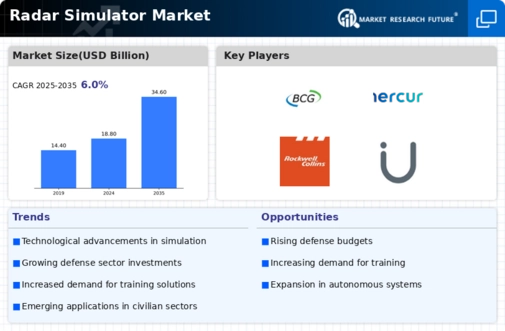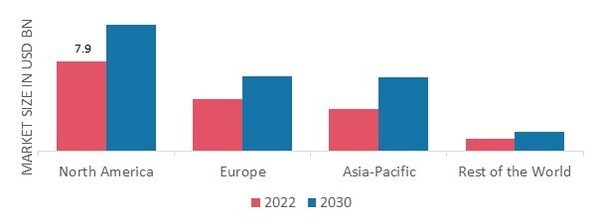Market Trends
Introduction
In 2023, the Radar Simulator Market is experiencing significant transformation driven by a confluence of macro factors including rapid technological advancements, evolving regulatory frameworks, and shifts in consumer behavior. The integration of artificial intelligence and machine learning into radar simulation technologies is enhancing operational efficiency and accuracy, while stringent regulations in defense and aviation sectors are necessitating more sophisticated training solutions. Additionally, the growing demand for realistic training environments among military and commercial aviation sectors is reshaping product offerings and driving innovation. For stakeholders, understanding these trends is crucial as they navigate a competitive landscape that increasingly prioritizes advanced simulation capabilities and compliance with regulatory standards.
Top Trends
-
Increased Adoption of AI and Machine Learning
The integration of AI and machine learning in radar simulators is enhancing their capabilities, allowing for more accurate simulations. For instance, AAI Corporation has developed systems that utilize AI for real-time data processing, improving operational efficiency. This trend is expected to streamline training processes, reducing time and costs associated with traditional methods. As AI technology continues to evolve, its application in radar simulation will likely expand, leading to more sophisticated training environments. -
Growing Demand for Military Applications
Military organizations are increasingly investing in radar simulators for training purposes, with a focus on enhancing combat readiness. Countries like the US and India are expanding their defense budgets, allocating significant funds for advanced simulation technologies. This trend is driving innovation among key players, as they develop tailored solutions for military training. The emphasis on realistic training scenarios is expected to lead to more partnerships between governments and simulation providers. -
Focus on Civil Aviation Training
Civil aviation authorities are prioritizing radar simulation for pilot training to improve safety and operational efficiency. For example, Rockwell Collins has introduced advanced simulators that replicate real-world air traffic scenarios. The increasing number of air traffic incidents has prompted regulatory bodies to mandate enhanced training protocols, boosting demand for sophisticated simulators. This trend is likely to result in more collaborations between aviation authorities and simulation companies. -
Advancements in Virtual Reality (VR) Integration
The incorporation of VR technology into radar simulators is revolutionizing training methodologies, providing immersive experiences for users. Companies like Buffalo Computer Graphics are leading the way in developing VR-enabled simulators that enhance situational awareness. This trend is expected to improve user engagement and retention of information during training sessions. As VR technology becomes more accessible, its integration into radar simulation will likely become standard practice. -
Emphasis on Cybersecurity in Simulation Systems
With the rise of cyber threats, there is a growing emphasis on cybersecurity measures within radar simulation systems. Key players are investing in secure software solutions to protect sensitive data during training exercises. For instance, Mercury Systems has implemented robust cybersecurity protocols in their simulators to safeguard against potential breaches. This trend is crucial for maintaining the integrity of training environments and is expected to shape future developments in simulation technology. -
Expansion of Cloud-Based Simulation Solutions
Cloud technology is facilitating the development of scalable radar simulation solutions, allowing for remote access and collaboration. Companies like Adacel Technologies are offering cloud-based platforms that enable users to conduct training from various locations. This trend is enhancing flexibility and reducing infrastructure costs for organizations. As cloud technology continues to advance, its adoption in radar simulation is expected to grow, leading to more innovative training solutions. -
Integration of Multi-Domain Operations
The trend towards multi-domain operations is influencing radar simulation development, as military forces seek to train for joint operations across air, land, and sea. Harris Corporation is at the forefront of creating simulators that support this integrated approach. This trend is expected to enhance interoperability among allied forces, improving overall mission effectiveness. Future developments may include more comprehensive simulation environments that encompass various operational domains. -
Sustainability and Energy Efficiency Initiatives
There is a growing focus on sustainability within the radar simulator market, with companies striving to develop energy-efficient systems. For example, Ultra Electronics is exploring eco-friendly materials and energy-saving technologies in their simulators. This trend is driven by increasing regulatory pressures and a corporate commitment to reducing environmental impact. As sustainability becomes a priority, it is likely to influence product design and operational practices in the industry. -
Customization and Tailored Solutions
The demand for customized radar simulation solutions is on the rise, as organizations seek training tools that meet specific operational needs. Cambridge Pixel Ltd is known for providing tailored simulators that address unique client requirements. This trend is fostering innovation and encouraging companies to develop more versatile products. As clients increasingly request bespoke solutions, the market is expected to see a shift towards more personalized offerings. -
Collaboration with Academic Institutions
Partnerships between radar simulation companies and academic institutions are becoming more common, fostering research and development in simulation technologies. For instance, Micro Nav Limited collaborates with universities to enhance simulation methodologies. This trend is expected to drive innovation and improve the quality of training programs. As these collaborations grow, they may lead to the development of cutting-edge technologies that further advance the radar simulator market.
Conclusion: Navigating the Radar Simulator Landscape
The Radar Simulator Market in 2023 is characterized by intense competitive dynamics and significant fragmentation, with both legacy and emerging players vying for market share. Regional trends indicate a growing demand in North America and Asia-Pacific, driven by advancements in defense and aerospace sectors. Vendors are strategically positioning themselves by leveraging capabilities in AI, automation, and sustainability to enhance product offerings and operational efficiency. As the market evolves, flexibility in adapting to customer needs and technological advancements will be crucial for leadership. Companies that can integrate these capabilities effectively will not only differentiate themselves but also capture the attention of key stakeholders in this rapidly changing landscape.

 Source Secondary Research, Primary Research, Market Research Future Database, and Analyst Review
Source Secondary Research, Primary Research, Market Research Future Database, and Analyst Review




Leave a Comment